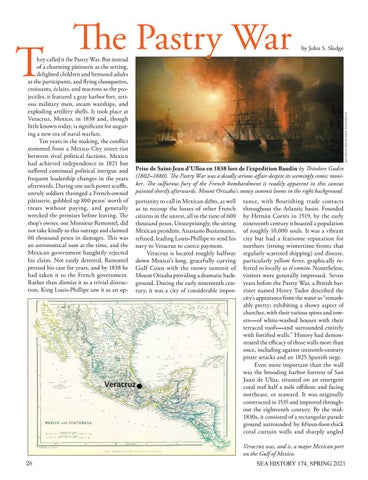hey called it the Pastry War. But instead of a charming pâtisserie as the setting, delighted children and bemused adults as the participants, and flying chouquettes, croissants, éclairs, and macrons as the projectiles, it featured a gray harbor fort, serious military men, steam warships, and exploding artillery shells. It took place at Veracruz, Mexico, in 1838 and, though little known today, is significant for auguring a new era of naval warfare. Ten years in the making, the conflict stemmed from a Mexico City street riot between rival political factions. Mexico had achieved independence in 1821 but suffered continual political intrigue and frequent leadership changes in the years afterwards. During one such power scuffle, unruly soldiers thronged a French-owned pâtisserie, gobbled up 800 pesos’ worth of treats without paying, and generally wrecked the premises before leaving. The shop’s owner, one Monsieur Remontel, did not take kindly to this outrage and claimed 60 thousand pesos in damages. This was an astronomical sum at the time, and the Mexican government haughtily rejected his claim. Not easily deterred, Remontel pressed his case for years, and by 1838 he had taken it to the French government. Rather than dismiss it as a trivial distraction, King Louis-Phillipe saw it as an op-
by John S. Sledge
réunion des musées nationaux
T
The Pastry War
Prise de Saint-Jean d’Ulloa en 1838 lors de l’expedition Baudin by Théodore Gudin (1802–1880). The Pastry War was a deadly serious affair despite its seemingly comic moniker. The sulfurous fury of the French bombardment is readily apparent in this canvas painted shortly afterwards. Mount Orizaba’s snowy summit looms in the right background. portunity to call in Mexican debts, as well as to recoup the losses of other French citizens in the unrest, all to the tune of 600 thousand pesos. Unsurprisingly, the sitting Mexican president, Anastasio Bustamante, refused, leading Louis-Phillipe to send his navy to Veracruz to coerce payment. Veracruz is located roughly halfway down Mexico’s long, gracefully curving Gulf Coast with the snowy summit of Mount Orizaba providing a dramatic background. During the early nineteenth century, it was a city of considerable impor-
Veracruz
tance, with flourishing trade contacts throughout the Atlantic basin. Founded by Hernán Cortés in 1519, by the early nineteenth century it boasted a population of roughly 10,000 souls. It was a vibrant city but had a fearsome reputation for northers (strong wintertime fronts that regularly scattered shipping) and disease, particularly yellow fever, graphically referred to locally as el vomito. Nonetheless, visitors were generally impressed. Seven years before the Pastry War, a British barrister named Henry Tudor described the city’s appearance from the water as “remarkably pretty; exhibiting a showy aspect of churches, with their various spires and towers—of white-washed houses with their terraced roofs—and surrounded entirely with fortified walls.” History had demonstrated the efficacy of those walls more than once, including against sixteenth-century pirate attacks and an 1825 Spanish siege. Even more important than the wall was the brooding harbor fortress of San Juan de Ulúa, situated on an emergent coral reef half a mile offshore and facing northeast, or seaward. It was originally constructed in 1535 and improved throughout the eighteenth century. By the mid1830s, it consisted of a rectangular parade ground surrounded by fifteen-foot-thick coral curtain walls and sharply angled Veracruz was, and is, a major Mexican port on the Gulf of Mexico.
26
SEA HISTORY 174, SPRING 2021
